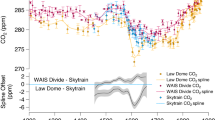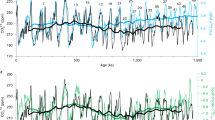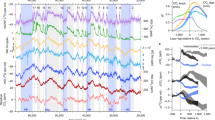Abstract
A high-resolution ice-core record of atmospheric CO2 concentration over the Holocene epoch shows that the global carbon cycle has not been in steady state during the past 11,000 years. Analysis of the CO2 concentration and carbon stable-isotope records, using a one-dimensional carbon-cycle model,uggests that changes in terrestrial biomass and sea surface temperature were largely responsible for the observed millennial-scale changes of atmospheric CO2 concentrations.
This is a preview of subscription content, access via your institution
Access options
Subscribe to this journal
Receive 51 print issues and online access
$199.00 per year
only $3.90 per issue
Buy this article
- Purchase on Springer Link
- Instant access to full article PDF
Prices may be subject to local taxes which are calculated during checkout



Similar content being viewed by others
References
Keeling, C. D. & Whorf, T. P. in Trends '93: A compendium of Data on Global Change (eds Boden, T. A., Kaiser, D. P., Sepanski, R. J. & Stoss, F. W.) 16–26 (Carbon Dioxide Information Analysis Center, Oak Ridge, (1994); update available at 〈http://cdiac.esd.ornl.gov/ndps/ndp001.html〉.
Neftel, A., Moor, E., Oeschger, H. & Stauffer, B. Evidence from polar ice cores for the increase in atmospheric CO2 in the past two centuries. Nature 315, 45– 47 (1985).
Barnola, J.-M. et al. CO2 evolution during the last millennium as recorded by Antarctic and Greenland ice. Tellus B 47, 264–272 (1995).
Etheridge, D. M. et al. Natural and anthropogenic changes in atmospheric CO2 over the last 1000 years from air in Antarctic ice and firn. J. Geophys. Res. 101, 4115–4128 (1996).
Neftel, A., Oeschger, H., Staffelbach, T. & Stauffer, B. CO2 record in the Byrd ice core 50,000–5,000 years BP. Nature 331, 609–611 (1988).
Stauffer, B. et al. Atmospheric CO2 concentration and millennial-scale climate change during the last glacial period. Nature 392, 59–62 (1998).
Barnola, J.-M., Pimienta, P., Raynaud, D. & Korotkevich, Y. S. CO2 -climate relationship as deduced from the Vostok ice core: a re-examination based on new measurements and on a re-evaluation of the air dating. Tellus B 43, 83– 90 (1991).
Keeling, C. D., Mook, W. G. & Tans, P. P. Recent trends in the 13C/12C ratio of atmospheric carbon dioxide. Nature 277, 121–123 (1979).
Francey, R. J. et al. Changes in oceanic and terrestrial carbon uptake since 1982. Nature 373, 326–330 (1995).
Francey, R. J. et al. A1000 year high precision record of δ13C in atmospheric CO2. Tellus(in the press).
Leuenberger, M., Siegenthaler, U. & Langway, C. C. Carbon isotope composition of atmospheric CO 2 during the last ice age from an Antarctic ice core. Nature 357, 488–490 ( 1992).
Keeling, C. D., Whorf, T. P., Wahlen, M. & Plicht, J. v. d. Interannual extremes in the rate of rise of atmospheric carbon dioxide since 1980. Nature 375, 666–670 ( 1995).
Joos, F. & Bruno, M. Long-term variability of the terrestrial and oceanic carbon sinks and the budgets of the carbon isotopes 13C and 14C. Glob. Biogeochem. Cycles 12, 277–295 (1998).
Anklin, M., Barnola, J.-M., Schwander, J., Stauffer, B. & Raynaud, D. Processes affecting the CO 2 concentrations measured in Greenland ice. Tellus B 47, 461–470 (1995).
Smith, H. J., Wahlen, M., Mastroianni, D. & Taylor, K. C. The CO2 concentration of air trapped in GISP2 ice from the Last Glacial Maximum-Holocene transition. Geophys. Res. Lett. 24, 1–4 (1997).
Smith, H. J., Wahlen, M., Mastroianni, D., Taylor, K. C. & Mayewski, P. The CO2 concentration of air trapped in Greenland Ice Sheet Project 2 ice formed during periods of rapid climate change. J.Geophys. Res. 102, 26577–26582 (1997).
Delmas, R. J. Anatural artefact in Greenland ice-core CO2 measurements. Tellus B 45, 391–396 ( 1993).
Tschumi, J. & Stauffer, B. Reconstructing the past atmospheric CO2 -concentration based on ice core analyses: open questions due to in situ production of CO2 in the ice. J. Glaciol. (submitted).
Raynaud, D. et al. The ice record of greenhouse gases. Science 259, 926–934 (1993).
Miller, S. L. Clathrate hydrates of air in Antarctic ice. Science 165, 489–490 (1969).
Steig, E. J., Morse, D. L., Waddington, E. D. & Polissar, P. J. Using the sunspot cycle to date ice cores. Geophys. Res. Lett. 25, 163–166 ( 1998).
Waddington, E. D. & Morse, D. L. Spatial variations of local climate at Taylor Dome, Antarctica: Implications for paleoclimate from ice cores. Ann. Glaciol. 20, 219– 225 (1994).
Steig, E. J. et al. Sychronous climate changes in Antarctica and the North Atlantic. Science 282, 92–95 (1998).
Martinerie, P. et al. Air content paleo record in the Vostok ice core (Antarctica): A mixed record of climatic and glaciological parameters. J. Geophys. Res. 99, 10565–10576 ( 1994).
Fitzpatrick, J. J. Preliminary report on the physical and stratigraphic properties of the Taylor Dome ice core. Antarct. J. US 29, 84– 86 (1994).
Brook, E. J., Severinghaus, J., Harder, S. & Bender, M. Atmospheric methane and millennial scale climate change.In Mechanisms of Millennial Scale Climate Change(Monogr, Am. Geophys. Union, Washington DC, in the press).
Schwander, J. & Stauffer, B. Age difference between polar ice and the air trapped in its bubbles. Nature 311, 45–47 (1984).
Sucher, C. M. Atmospheric Gases in the Taylor Dome Ice Core: Implications for East Antarctic Climate Change Thesis, Univ. Rhode Island(1997).
Leuenberger, M. & Siegenthaler, U. Ice-age atmospheric concentration of nitrous oxide from an Antarctic ice core. Nature 360, 449–451 ( 1992).
Broecker, W. S. & Peng, T.-H. Tracers in the Sea (Lamont-Doherty Geological Observatory, Palisades, ( 1982).
Bruno, M. & Joos, F. Terrestrial carbon storage during the past 200 years: A Monte Carlo analysis of CO2 data from ice core and atmospheric measurements. Glob. Biogeochem. Cycles 11, 111–124 (1997).
Joos, F. et al. An efficient and accurate representation of complex oceanic and biospheric models of anthropogenic carbon uptake. Tellus B 48, 397–417 (1996).
Archer, D., Kheshgi, H. & Maier-Reimer, E. Multiple timescales for neutralization of fossil fuel CO2. Geophys. Res. Lett. 24, 405–408 (1997).
Archer, D. & Maier-Reimer, E. Effect of deep-sea sedimentary calcite preservation on atmospheric CO2 concentration. Nature 367, 260–263 ( 1994).
Bard, E. et al. Deglacial sea-level record from Tahiti corals and the timing of global meltwater discharge. Nature 382, 241–244 (1996).
Takahashi, T., Olafson, J., Goddard, J. D., Chipman, D. W. & Sutherland, S. C. Seasonal variation of CO 2 and nutrients in the high-latitude surface oceans: A comparative study. Glob. Biogeochem. Cycles 7, 843– 878 (1993).
Bacastow, R. B. The effect of temperature change of the warm surface waters of the oceans on atmospheric CO2. Glob. Biogeochem. Cycles 10, 319–333 (1996).
Mook, W. G. 13C in atmospheric CO2. Neth. J. Sea Res. 20, 211–223 (1986).
Bard, E., Rostek, F. & Sonzogni, C. Interhemispheric synchrony of the last deglaciation inferred from alkenone palaeothermometry. Nature 385 , 707–710 (1997).
Dahl-Jensen, D. et al. Past temperatures directly from the Greenland ice sheet. Science 282, 268–271 ( 1998).
Farquhar, G. D., Ehleringer, J. R. & Hubick, K. T. Carbon isotope discrimination and photosynthesis. Annu. Rev. Plant Physiol. Plant Mol. Biol. 40, 503–537 (1989).
Crowley, T. J. Ice age terrestrial carbon changes revisited. Glob. Biogeochem. Cycles 9, 377–389 ( 1995).
Street-Perrott, F. A. & Perrott, R. A. in Global Climates Since the Last Glacial Maximum (ed. Wright, H. E.) 318– 356 (Univ. Minnesota Press, Minneapolis, (1993).
Blunier, T., Chappellaz, J., Schwander, J., Stauffer, B. & Raynaud, D. Variations in atmospheric methane concentration during the Holocene epoch. Nature 374 , 46–49 (1995).
Hoelzmann, P. et al. Mid-Holocene land-surface conditions in northern Africa and the Arabian peninsula: A data set for the analysis of biogeophysical feedbacks in the climate system. Glob. Biogeochem. Cycles 12, 35–51 (1998).
Esser, G. & Lautenschlager, M. Estimating the change of carbon in the terrestrial biosphere from 18000 BP to present using a carbon cycle model. Environ. Pollut. 83, 45–53 (1994).
Wahlen, M., Allen, D., Deck, B. & Herchenroder, A. Initial measurements of CO2 concentrations (1530 to 1940 AD) in air occluded in the GISP2 ice core from Central Greenland. Geophys. Res. Lett. 18, 1457–1460 ( 1991).
Enting, I. G. On the use of smoothing spline to filter CO2 data. J. Geophys. Res. 92, 10977–10984 (1987).
Acknowledgements
We thank J. Palais, P. Grootes, T. Crowley, S. Björck, P. Clark, G. Esser, R. J. Francey, D. Jolly and E. Waddington for support; E. Brook, P. Grootes, C. Sucher and E. Steig for sharing data; the US NSF for permitting us to analyse the samples and G. Hargreaves (NICL) for preserving them from melting. We thank J.-M. Barnola, M. Leuenberger and O. Marchal for discussions. This work was supported by the US NSF OPP, the Swiss NSF, EPRI, BBW and BEW.
Author information
Authors and Affiliations
Corresponding author
Rights and permissions
About this article
Cite this article
Indermühle, A., Stocker, T., Joos, F. et al. Holocene carbon-cycle dynamics based on CO2 trapped in ice at Taylor Dome, Antarctica. Nature 398, 121–126 (1999). https://doi.org/10.1038/18158
Received:
Accepted:
Issue Date:
DOI: https://doi.org/10.1038/18158
This article is cited by
-
Niche partitioning among odontocetes in a marine biogeographic transition zone of the western South Atlantic Ocean
Marine Biology (2024)
-
Mechanisms and impacts of enhanced rainfall over large islands in the Maritime Continent during the mid-holocene
Climate Dynamics (2024)
-
Archaeological sharks: changes in the trophic ecology between late Holocene and modern shark communities in South Brazil
Marine Biology (2023)
-
Variation in the trophic niche and food provisioning between the early and late chick-rearing stages in Magellanic penguins Spheniscus magellanicus at Martillo Island, Tierra del Fuego, Argentina
Marine Biology (2023)
-
Complex spatio-temporal structure of the Holocene Thermal Maximum
Nature Communications (2022)
Comments
By submitting a comment you agree to abide by our Terms and Community Guidelines. If you find something abusive or that does not comply with our terms or guidelines please flag it as inappropriate.



